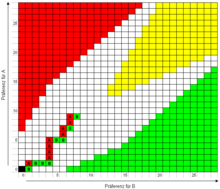Significance pants
The significance pants is a sequential, statistical significance test developed by the US military. The name is derived from the graphic evaluation scheme, which is similar to pants . The method can be used to derive significant statements from a small number of samples or surveys (usually no more than 30).
method
The significance pants are used when tests or interviews have two possible outcomes. In the field of marketing , for example, it is used to assess a possible product success: test persons are asked whether they prefer an old product A or a new product B. (As a rule, more differentiated questions are asked in order to determine afterwards whether a person has a clear tendency towards A or clearly towards B.) The individual results are then graphically inserted in a trouser scheme (see graphic). This scheme is based on various statistical evaluations and can be used directly in this form , especially for potential analysis in marketing.
Starting from the zero point z. B. with preference A one step upwards selected, with preference B one step to the right. If the sequence develops graphically into the left "trouser leg", option A is preferred; according to option B on the right pant leg. Since clear statements can be read from even relatively small samples, the significance pants are a popular way of analyzing customer needs and product potential, especially with low marketing budgets.
